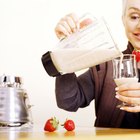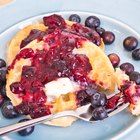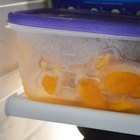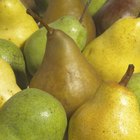baibaz/iStock/GettyImages
Smoothies not only quench thirst, but they can stand in for a meal, especially when they're packed with fruits, vegetables or protein-rich binders. Most blenders are large enough to make at least three or four servings of smoothies, so it makes sense to make them ahead of time when you can. Once blended, you can enjoy a refrigerated smoothie for about a day.
Ingredients
In most cases, you can make smoothies ahead and refrigerate them for up to 24 hours or pack them in an insulated container and take them with you. There are a few exceptions, though. Use smoothies made with ice cubes immediately, rather than storing them. As the ice cubes melt, the fruit puree separates from the water, leaving a soggy, uninspiring mess. Sometimes fruits that turn brown can discolor a smoothie that's been made ahead of time. Bananas, in particular, have this tendency. Pair them with brightly colored fruits like strawberries, or greens, such as kale, to keep the color bright.
Safety
Smoothies are considered a health food, and in most cases, they are. But remember to follow good food hygiene as you make them. Always wash fresh fruit and vegetables and peel them when possible. Vegetables and fruits can carry pathogens, such as the E.coli bacteria. Don't use raw, unpasteurized eggs in smoothies because of the risk of salmonella food poisoning, and always refrigerate smoothies immediately. Pack them in an insulated thermos for up to 12 hours. Be especially vigilant with smoothies that contain dairy products, such as yogurt and milk, since these foods are highly perishable.
Results
Some smoothie recipes store better than others so your best bet is simply to experiment. If a smoothie separates, shake it or throw it in the blender before drinking it. Try adding binders, such as coconut milk, almond milk, peanut butter or carob, to your smoothie to create a creamy texture. You can also add flavorings, such as honey, vanilla or almond extract. Be sure to use real vanilla and almond extract, though, since imitations can impart a bitter flavor that becomes more pronounced as the smoothie sits in the fridge.
Alternatives
Smoothies sometimes require quite a bit of prep work in the form of peeling and chopping fruits and vegetables. If you lack time in the morning to conquer this task, try prepping and freezing the ingredients ahead of time. Chop fruits and vegetables into one-inch cubes and pack them in heavy-duty plastic bags. Pack enough in each bag for one batch of smoothies. Label the smoothies, store them in the freezer and use them within one month for best quality. The freezer must be kept at zero degrees Fahrenheit or colder to adhere to USDA food safety guidelines.
Related Articles

How to Store Smoothies in the Fridge
Can You Prepare Smoothies in Bulk & ...

Fresh Homemade Orange Juice Will Stay ...

How Long Can Cupcakes Be Stored After ...

What Is the Freezing Point of Fruit ...
How to Freeze Papaya

How to Freeze Fresh Watermelon
6 Healthy Strawberry Banana Smoothie ...

How to Make Blueberry Jam

How to Make Melon Ice Cream
How Long Is it Safe to Keep Frozen ...

Are Bananas Safe to Eat if the Skin Is ...
How Long Can Cupcakes Be Stored After ...

Can You Freeze Apricots?

Why Are My Smoothies Chunky?

How to Keep Cucumber Juice Fresh

What Is an Obagi Blender?

How Do I Prepare Pears for Freezing?

How to Make a Lip Mask for Extremely ...

How to Make Fresh Strawberry Frosting ...
References
- The Ultimate Smoothie Book; Cherie Calbom; 2006
- Whole Health Designs: The 1 Smoothie Trick I Can't Live Without
- US Food and Drug Administration: Playing It Safe With Eggs
- US Food and Drug Administration: Raw Produce: Selecting and Serving It Safely
- Clemson University Cooperative Extension: Safe Handling of Milk & Dairy Products
- USDA: Freezing and Food Safety
- Thermos: Food Storage
Writer Bio
Julie Christensen is a food writer, caterer, and mom-chef. She's the creator of MarmaladeMom.org, dedicated to family fun and delicious food, and released a book titled "More Than Pot Roast: Fast, Fresh Slow Cooker Recipes."